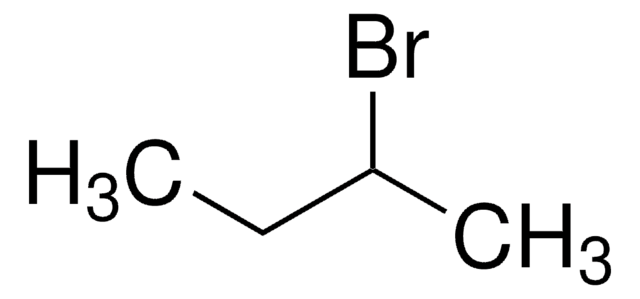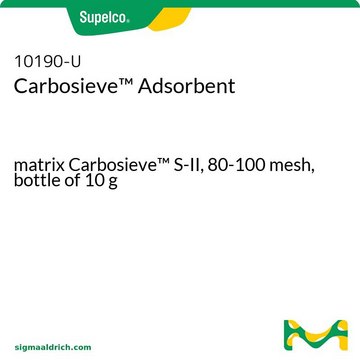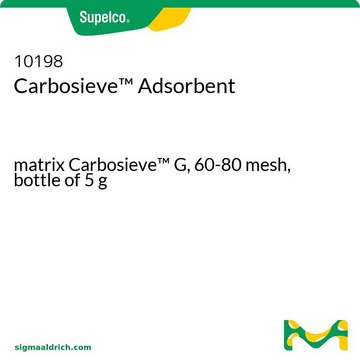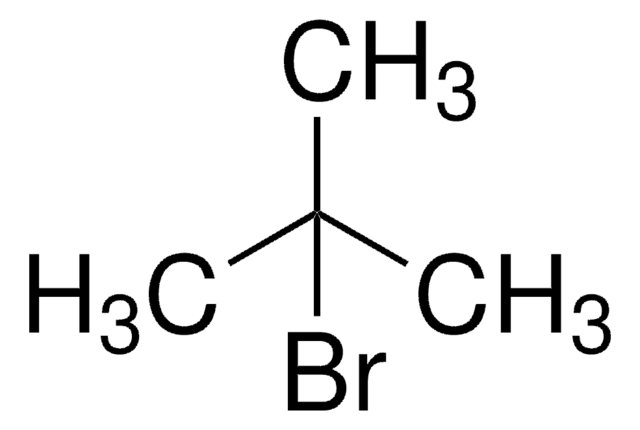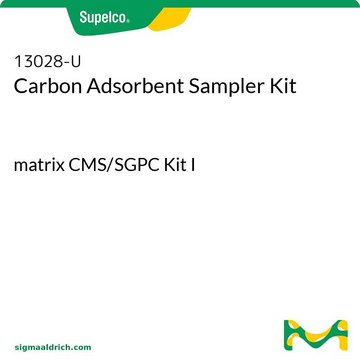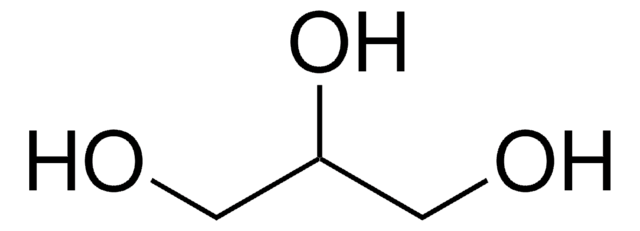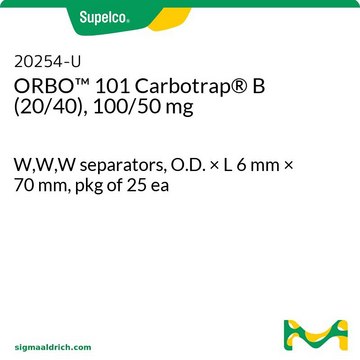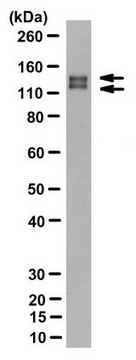10197
Carbosieve Carbon Adsorbent
matrix Carbosieve G, 45-60 mesh, bottle of 5 g
About This Item
Recommended Products
Product Name
Carbosieve Adsorbent, matrix Carbosieve G, 45-60 mesh, bottle of 5 g
product line
Carbosieve
form
powder, crystals or granules
packaging
bottle of 5 g
technique(s)
LPLC: suitable
gas chromatography (GC): suitable
solid phase extraction (SPE): suitable
surface area
~1160 m2/g
matrix
Carbosieve G
matrix active group
carbon
particle size
45-60 mesh
pore size
~0.02 cm3/g mesoporosity
~0.49 cm3/g microporosity
~0 cm3/g macroporosity
~6-15 Å pore diameter
density
~0.27 g/mL (free fall density)
separation technique
reversed phase
Looking for similar products? Visit Product Comparison Guide
General description
- Spherical (better packed bed performance than granular particles)
- Hard and non-friable (pack well, will not break)
- Highly porous (high surface areas)
- Used for molecules with an analyte size relative to C2-C5 n-alkanes
- Hydrophobic (can be used in high humidity environments)
Generally, CMS adsorbents offer greater relative adsorptive strength compared to spherical graphitized polymer carbon (SGPC) and graphitized carbon black (GCB) adsorbents. Our Carbosieve products are a type of CMS adsorbent.
- Have non-tapered pores
- Very strong adsorptive strength due to only containing micropores
- Provide great performance for many small, volatile analytes that most adsorbents have trouble retaining
For more information about any of our specialty carbon adsorbents, please visit sigma-aldrich.com/carbon
Legal Information
Storage Class Code
4.1B - Flammable solid hazardous materials
WGK
WGK 3
Flash Point(F)
Not applicable
Flash Point(C)
Not applicable
Personal Protective Equipment
Regulatory Information
Choose from one of the most recent versions:
Certificates of Analysis (COA)
It looks like we've run into a problem, but you can still download Certificates of Analysis from our Documents section.
If you need assistance, please contact Customer Support.
Already Own This Product?
Find documentation for the products that you have recently purchased in the Document Library.
Which document(s) contains shelf-life or expiration date information for a given product?
If available for a given product, the recommended re-test date or the expiration date can be found on the Certificate of Analysis.
How do I get lot-specific information or a Certificate of Analysis?
The lot specific COA document can be found by entering the lot number above under the "Documents" section.
Is this product a packed column?
This is packing material only; it is not a column. Some endusers will purchase this bottle of packing and prepare their own packed columns.
How can I purchase a column that is packed with this material?
Most packed column are custom made and require that you obtain a quotation. Please contact our Customer & Sales Services group at phone number (800)-247-6628, fax number (800)-447-3044 or email CIBelle@sial.com for additional information.
How do I find price and availability?
There are several ways to find pricing and availability for our products. Once you log onto our website, you will find the price and availability displayed on the product detail page. You can contact any of our Customer Sales and Service offices to receive a quote. USA customers: 1-800-325-3010 or view local office numbers.
What is the Department of Transportation shipping information for this product?
Transportation information can be found in Section 14 of the product's (M)SDS.To access the shipping information for this material, use the link on the product detail page for the product.
What is the maximum temperature for this packing?
The maximum temperature for this packing is 200 °C.
My question is not addressed here, how can I contact Technical Service for assistance?
Ask a Scientist here.
Our team of scientists has experience in all areas of research including Life Science, Material Science, Chemical Synthesis, Chromatography, Analytical and many others.
Contact Technical Service